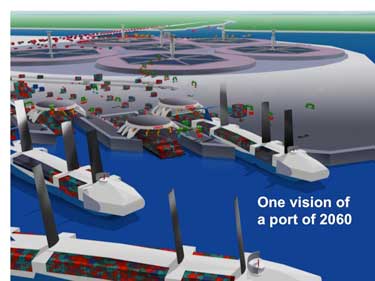Navis, a marine terminal technology company, holds a conference every two years. The event drew over 400 attendees from nearly thirty countries making San Francisco, for at least three-days, the epicenter of thought, on container terminal automation.By George Lauriat, AJOTNavis, a technology company specializing in cargo movement for marine, biennially holds its “Navis World” conference in San Francisco, inviting customers, vendors and partners. With nearby Silicon Valley, the “City by the Bay” is appropriate venue for a tech-oriented conference on container terminals. Navis, the host for the conference, is a technology pioneer for container terminal operations. But simply saying Navis is a “technology company” is a little saying Michael Jordan was a basketball player. The Oakland-based company, part of the Cargotec group, is the world’s leading innovator and developer of software for container terminals and has ubiquitous presence in container terminals around the world and that was reflected in this year’s conference draw.
 (L to R) Olili Isotalo – President of Terminal, Cargotec; Bill Walsh – CEO, Navis
(L to R) Olili Isotalo – President of Terminal, Cargotec; Bill Walsh – CEO, Navis
Navis World 2012, the 9th conference of its kind, was held October 7-10 at the San Francisco Intercontinental Hotel and attracted over 450 attendees from nearly thirty countries. There was some glitz to the proceedings, which is traditional for tech conferences, not quite on an Apple level, but when Navis CEO Bill Walsh burst out of “container door” on stage to open the conference, there was no doubt this wasn’t going to be your standard shipping conference.
The feel at Navis World is that the conference is more an interactive collaborative – a sort of rolling “open source” affair on terminal automation. Navis software is itself a collaborative, incorporating products from other technology companies like Honeywell, Oracle, AECOM, APS, Zebra, Identec Solutions and Verisant, is part of the collaborative process. But Navis’ own products in turn become the nexus of information for wide variety of other follow on port and terminal applications.
The conference isn’t for the faint hearted, as attendees rolled to some sixty sessions spread over three floors, and taking the stairs to avoid pileups at the elevators soon became the SOP.
Most of the sessions were directly related to Navis products and/or projects. For example, “What’s New in SPARCS N4 release 2.4 and What to Expect in release 2.5”. Still other sessions “Navis and Cargotec Collaboration for Automated Shuttle Carriers” illustrated how the software and hardware were being developed to automate terminals.
But a number of other sessions were focused on the marine terminal sector and what the future might hold. It was interesting to watch the auto-stats in Patrick Terminal in Brisbane move boxes within the container yard. The presentation poses the question of just how far into the future is a wholly automated terminal? And how far long it will be before terminals are run offsite?
Arguably, recently appointed President of Terminals for Cargotec, Olli Isotalo, made the presentation that knitted the whole conference package together during the opening ceremonies. His presentation involved what would a terminal look like in 2060. The ideas for the power point presentation were solicited from Cargotec employees (and their families) and while some of the ideas seem lie they’ll happen tomorrow (blocks of containers for a single lift) whiles others might have seemed far fetched (container transported by air or mag lev movements) the intent is clear – the containerized transportation system and the container terminal, as we know it now, will change and change begins with automating box movements within the terminals.
 Artist rendering of Cargotec’s vision of the future.
Artist rendering of Cargotec’s vision of the future.
 (L to R) Olili Isotalo – President of Terminal, Cargotec; Bill Walsh – CEO, Navis
(L to R) Olili Isotalo – President of Terminal, Cargotec; Bill Walsh – CEO, Navis
 Artist rendering of Cargotec’s vision of the future.
Artist rendering of Cargotec’s vision of the future.
 (L to R) Olili Isotalo – President of Terminal, Cargotec; Bill Walsh – CEO, Navis
(L to R) Olili Isotalo – President of Terminal, Cargotec; Bill Walsh – CEO, Navis
 Artist rendering of Cargotec’s vision of the future.
Artist rendering of Cargotec’s vision of the future.